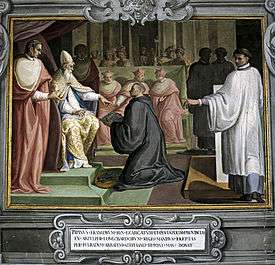
Pope Stephen II
Pope Stephen II (Latin: Stephanus II (or III); 715[citation needed] – 26 April 757) was Pope from 26 March 752 to his death in 757. He succeeded Pope Zachary following the death of Pope-elect Stephen (sometimes called Stephen II). Stephen II marks the historical delineation between the Byzantine Papacy and the Frankish Papacy.
Allegiance to Constantinople
The Lombards to the north of Rome had captured Ravenna, capital of the Eastern Roman Empire Exarchate of Ravenna, in 751, and began to put pressure on the city of Rome.
Relations were very strained in the mid-8th century between the papacy and the Eastern Roman emperors over the support of the Isaurian Dynasty for iconoclasm. Likewise, maintaining political control over Rome became untenable as the Eastern Roman Empire itself was beset by the Abbasid Caliphate to the south and Bulgars to the northwest. As a result, Rome was unable to secure military support from Constantinople to push back Lombard forces.
Alliance with the Franks
Stephen II
Stephen II may refer to:

Pope-elect Stephen
Pope-elect Stephen II was a Roman priest elected pope in March 752 to succeed Zachary; he died of a stroke a few days later, before being ordained a bishop. In 745, Zachary had made him a cardinal presbyter, with the titulus of San Crisogono, the same titulus later held by Cardinal Frederick of Lorraine, who became Pope Stephen IX.
The Annuario Pontificio attaches to its mention of Stephen II (III) the footnote: "On the death of Zachary the Roman priest Stephen was elected; but, since he died three days later and before his consecratio, which according to the canon law of the time was the true commencement of his pontificate, his name is not registered in the Liber Pontificalis nor in other lists of the popes."
From 752 to 942, eight who bore the name Stephen, including this priest, were elected pope, but only seven reigned as pope. Regnal numbering was not used for popes until the 10th century, and any numbering attached to them has been applied posthumously. The first pope to take the name Stephen after numbering became customary was called Stephen IX during his lifetime and signed all his documents "Stephanus Papa Nonus".
Stephen II of Naples
Stephen II (died 799) was the duke of Naples during an important transitionary period in its history, from 755 to his death. He was styled as eminentissimus consul and was the leader of the local aristocracy when he was appointed by the patrician of Sicily. By the end of his reign, through a rupture with the Byzantine Empire, Naples was practically independent. After his abdication, Naples experienced a period of crisis until the election of Sergius I in 840.
At the beginning of his reign, Naples was still a loyal dukedom of the Byzantines, her dukes appointed by the emperor. In 761, therefore, she denied entry to the papal envoy, the Bishop Paul, an opponent of the iconoclasm then gripping the Byzantine world. Stephen was no less a supporter of the iconoclasm than the emperor himself. At that time, Stephen addressed Antiochos, the patrician of Sicily and his technical overlord, as "our lord" and "most excellent patrikios and protostrategos" (763). By 764, however, Naples had thrown off iconoclasm and Paul was able to take up his see.
Pope Stephen
Pope Stephen may refer to:
See also
Podcasts:
Latest News for: pope stephen ii
New Display Case for Better Protection of the Crown Jewels in Parliament
Hungary Today 18 Mar 2025- 1

